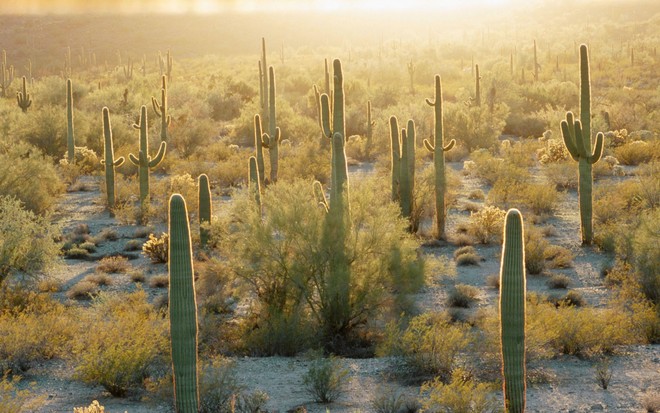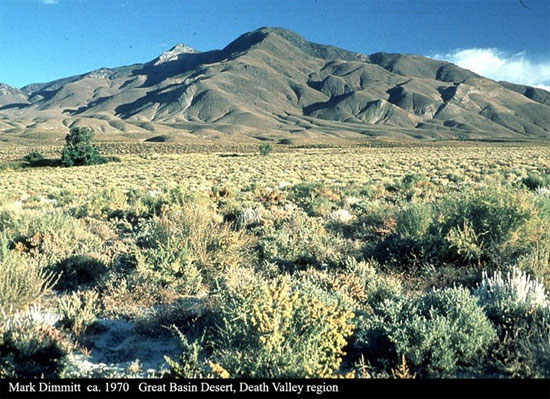10 desert - big desert in the world
Thinking about the desert, perhaps the first image that appears in our heads is endless sand hills, but the sandstorm is dry and a sky with only the harsh sun. For many years, under the influence of nature and mainly humans, desertification rates have been increasing.
There are many primitive deserts that are forests or human habitats, but now they have become a place where only the most thorny animals / plants can survive. This article is listed, introducing the 10 largest deserts in the world today.
10. Chihuahua Desert

The area of this desert is estimated at 282,000 square kilometers (175,000 square miles). The Chihuahua Desert lies along the Mexican-American border . Its area is even larger than California state (according to the statistics of the University of New Mexico). The desert is so named because it covers much of Mexico's Chihuahua state, in addition to the states of Texas, New Mexico and Arizona of the United States. The average rainfall per year in this desert is less than 228 mm.
Like many other deserts in the world, the Chihuahua Desert is surrounded by the Sierre Madre Occidental Mountains in the west and the Sierra Madre Oriental in the East, preventing steam from the Pacific and Gulf of Mexico from reaching the mainland.
There are more than 300 caves under the desert and Guadalupe Mountains of New Mexico. In this area, Carlsbad Caverns National Park was built after sulfuric acid entered the limestone mountain.
9. The Great Basin Desert

The area of this desert amounts to 490,000 square kilometers (about 190,000 square miles). Unlike most other deserts, the distinctive feature here is that most of the rain falls here in the form of snow. This desert covered range includes most Nevada , part of Utah and a few other states. Annual average rainfall in the area is only about 150 to 300 mm.
This desert is formed on the low side of the Sierra Nevada mountains in eastern California. The surrounding areas are also influenced by the desert. There are strong winds called Santa Ana that often blow south of California after being formed in high pressure areas in the Great Basin desert.
In the Great Basin desert area there are many strange rocks formed. For example, some types were found in central Nevada in 2009, their shape is described as "dripping like honey". This distortion occurs due to changes in the Earth's crust that are caused by high pressure and high temperatures below the Earth's surface. Heavy materials in the lithosphere when heated will overflow through thinner coatings, dragging the material behind.
8. Syrian desert

The area of this desert is about 518,000 square kilometers (about 200,000 square miles). It is truly a dead land when described as desolate and arid. The Syrian desert covered most of Iraq, Jordan, Saudi Arabia and Syria, where it was "marked " by lava - an insurmountable barrier to humans until recent decades. We now have highways and oil pipelines built along this area. The average annual rainfall in this area falls around 125mm.
Since ancient times, people have set foot in the Syrian desert. A few modern discoveries have confirmed that. The archaeological site called "Stonehenge of Syria " was discovered in 2009. A 2012 report by Discovery said it contained a lot of stone circles and tomb areas.
Es Safa volcano near Damascus is the largest volcano of Arabia. Lava holes have been active about 12,000 years ago in the Holocene Epoch. More recently, a boiling lava lake was found around the area in 1850.
7. Great Victoria Desert

The area of this desert amounts to 647,000 square kilometers (250,000 square miles). What a great land. The Great Victoria Star covers most of Australia primarily in the form of parallel sand dunes and some salt lakes. The sand dunes are mainly red sand from eastern Australia, they turn white when moving south due to mixing with sand from the beach.
This area is described as a place with unpredictable changes in precipitation . Tracking data from 1890 to 2005, the average rainfall here is only about 162 mm per year. Due to the harsh environment, deserts mainly consist of aboriginal lands, nature reserves or vacant land, without cities.
One of the region's biggest ecological threats comes from camels. Their ancestors were imported from India, Afghanistan and Saudi Arabia in the 19th century to serve in the desert. A recent report from the BBC said an estimated 750,000 wild camels are using a large water source and destroying infrastructure. They are considered as a short-term effective medium but have long-term consequences.
6. Patagonia Desert
The Great Victoria deserts are already wide, but let's visit the Patagonia desert with a huge area of 630,000 square kilometers (260,000 square miles). This desert belongs to Argentina . The desert and semi-desert areas stretch from the Atlantic Ocean to the Andes, mostly non-tree plains (Britannica encyclopedia).
Like the Death Valley in California, the Patagonia desert is located on the low-ridge side of the Andes . The harshness here is no less than the death valley. The average annual rainfall here is only 160 to 200 mm.
According to Susan Woodward, an honorary professor of geography at Radford Virginia University, the harsh environment here is mainly due to the influence of terrain. When air masses are forced to move around the mountain and deep depressions, they become hotter and the ability to hold steam also increases. On the lesser side of the mountain, the water evaporates very quickly, thus creating an arid desert environment.
5. Kalahari Desert
Fifth in the list is a desert of 930,000 square kilometers (360,000 square miles). Kalahari Desert covers a large area of South Africa, Botswana and Namibia. According to a Kalahari book published in 1991, the average rainfall in this desert is less than 500 mm a year. However, some places only receive 200 mm of rain water every year.
Kalahari is described as "nothing special". It is covered by sand, which may have been formed from 2.6 million to 11,700 years ago, due to the strong activity of wind and rain. The Kalahari Desert is also home to many human activities many thousands of years ago.
In an excavation area - the Wonderwerk cave in South Africa - archaeologists found evidence that fire had burned here about 1 million years ago. They also discovered artifacts in the Tsodilo, Botswana hills, suggesting that this place once performed sacrifices about 70,000 years ago.
4. Gobi Desert
Gobi Desert is one of the most famous deserts. The area of this desert is about 1.3 million square kilometers (800,000 square miles). The Gobi covers a large area of China and Mongolia. However, not anywhere on the Gobi is dry. Some places in the desert also have the weather form divided into two distinct rainy and dry seasons. The average annual rainfall varies from 50 to 200 mm depending on the location. The eastern area has a lot of rain in the summer, the monsoon activity is also stronger.
In 2011, models with zigzag shapes in Gobi appeared in photos taken by Google, creating a series of hypotheses, even ones related to aliens. But according to researcher Jonathon Hill at Arizona State University, these tracks are primarily to help China's spy satellites navigate the spacecraft.
Gobi Desert is the ideal place to excavate dinosaur fossils . A Tyrannosaurus Rex dinosaur skeleton was excavated in the area and auctioned for $ 1 million.
3. Arabian desert

The area of the Arabian desert is 2.3 million square kilometers (about 900,000 square miles). The Arabian desert covered Saudi Arabia, Oman and part of Iraq. Depending on the location, the desert dryness varies. In the center of the desert temperatures can reach 54 degrees Celsius. Areas near the desert edge or on plateaus are wetter, sometimes with fog and mist.
The average annual rainfall here is less than 100 mm, but depending on the location, it can range from 0 to 500 mm. Thanks to human irrigation, many parts of the desert have been greened. This is a good sign in the fact that the earth is deserted more and more.
However there are issues that need to be considered. The cultivation of circular trees became popular in Saudi Arabia in the past three decades. The engineers dug deep into the 20,000-year-old groundwater circuit to get irrigation water. It is expected that if current water usage continues, water will run out in the next 50 years.
2. Sahara Desert

The Sahara Desert covers an area of 8.6 million square kilometers, a figure larger than the above 8 desert areas combined. In addition to being larger than other deserts, the rainfall here is also much less. Annual precipitation is less than 25 mm, in the eastern desert, the annual rainfall can be reduced to only 5 mm. Water does not usually fall directly to rain in the Sahara but often creates fog. In the Sahara there is not much vegetation to retain heat after the Sun goes down, so the temperature can become very cold in the evening. The sudden change in temperature between day and night creates fog.
The Sahara also has a high volcano called Emi Koussi located in Chad, southeast of the Tibesti range. It lies at 3,415 meters above sea level, volcanic lava flows are still "young", about 2 million years old. Under normal notion, we always consider the Sahara as the largest desert in the world, but not really and we will discover that in the first place.
1. Antarctica

Yes, the world's largest desert is our Antarctic with an area of 14.2 million square kilometers (about 5.5 million square miles).
Antarctica is the coldest place in the world, many months do not receive the sun. Without the characteristics of ordinary deserts like hot, sandstorms, . it's hard to assume that a cold place like Antarctica is considered a desert. But due to the low rainfall, it is considered a desert , the annual average rainfall of Antarctica is only 50 mm and exists mainly in the form of snow. The reason for having so little snow but 99% of Antarctica's surface is covered by glaciers is because the average temperature at Antarctica is minus 48 degrees Celsius. And it slows down the evaporation process.
Due to climate change and global warming, many parts of Antarctica are showing signs of warming. The temperature in the past 50 years in Antarctica has increased 2.5 times - 5 times more than the rest of the whole earth. If seawater warms up, Antarctic ice will melt from below - places exposed to seawater.
- The most exotic deserts in the world
- The largest desert - desert in the world (1)
- The largest desert - desert in the world (2)
- Admire the world's oldest desert
- How are different deserts and deserts?
- In the driest desert in the world, there is a giant hand that is calling for help.
- The phenomenon of snowfall is very strange in the Atacama desert
- 'Miracle' in the town located in the world's most arid desert
- Believing that the most arid desert in the world is located in Antarctica
- The ghostly beauty of the desert
- Chinese desert covered in white snow in the weather -25 degrees Celsius
- The world's most arid desert turns into a colorful sea of flowers



 The 11 most unique public toilets in the world
The 11 most unique public toilets in the world Explore the ghost town in Namibia
Explore the ghost town in Namibia Rare historical moments are 'colored', giving us a clearer view of the past
Rare historical moments are 'colored', giving us a clearer view of the past The world famous ghost ship
The world famous ghost ship